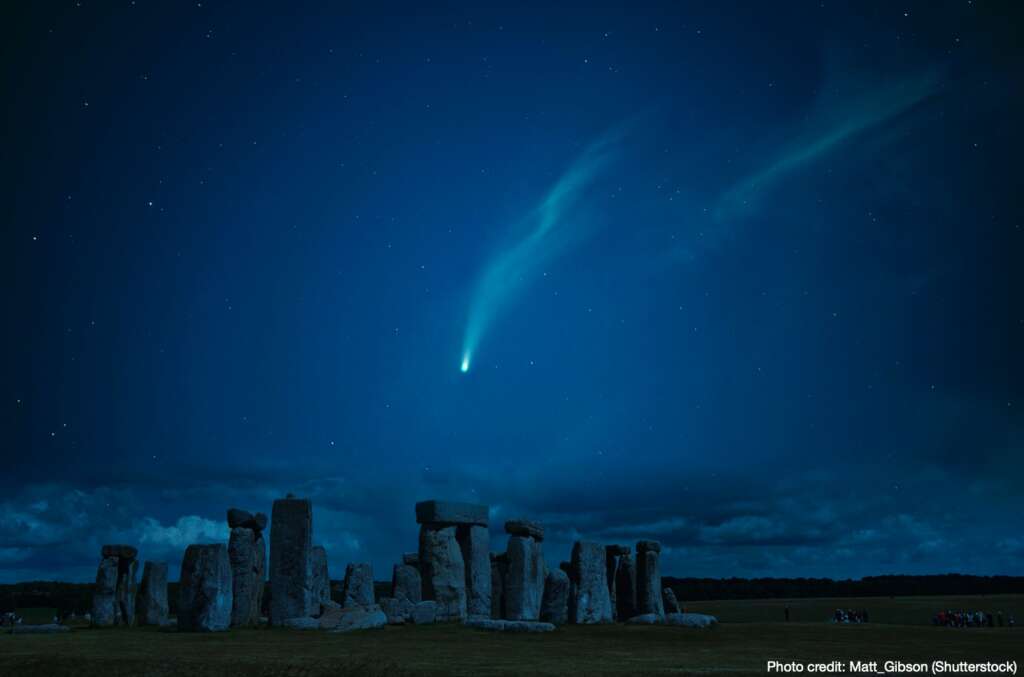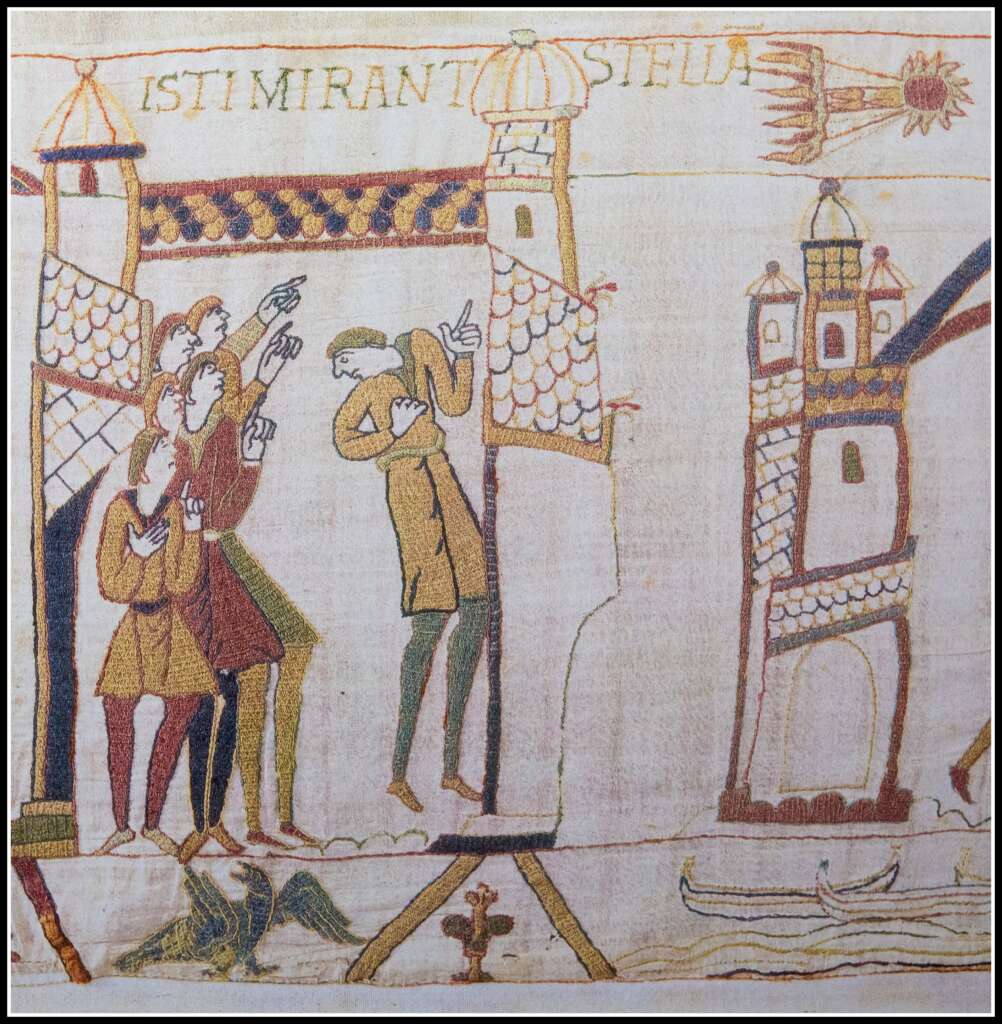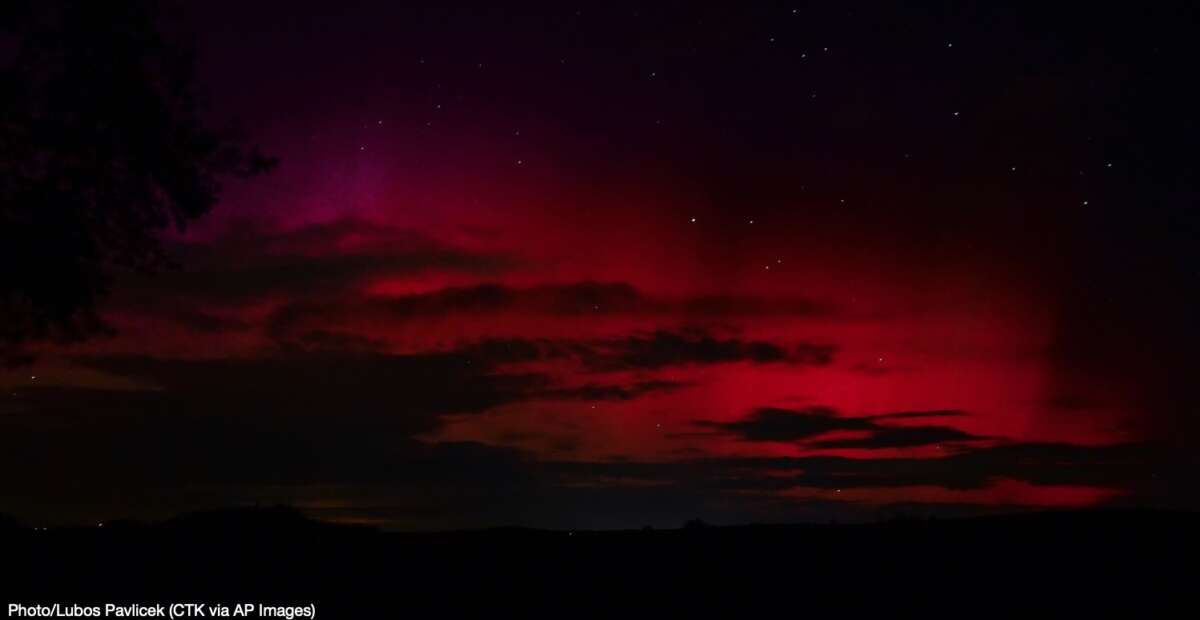People in the Ukraine, Hungary and Slovakia who looked to the heavens last evening saw a blood red sky. In England and elsewhere across Europe the sky was painted green, pale yellow or a faded pink instead. But over Kyiv, Ukraine, it was red. Blood red. A thousands years ago this might have been seen as sign of an impending doom. Even so today, in this modern age, it is still pretty creepy. In this post, I’d like to describe some of the more noteworthy signs & wonders in history
First, the science
What you see in the feature photo are the northern lights (the Aurora Borealis.) But you probably never have seen them cloaked in deep scarlet. The aurora are in fact typically white, green, pink blue, or violet as mentioned above, but rarely, in fact, almost never red as pictured here. The red coloring suggests intense solar activity among other things.
Solar particles enter the Earth’s atmosphere at 45,000,000 mph and slam into the Earth’s magnet field, eventually exciting molecules and gas. The reaction to this activity causes the various colors, of which green is the most common. The green coloring is characteristic of the presence of oxygen molecules while other colors indicate interaction with nitrogen. Other factors affecting the color or intensity of the lights involve perceptions which may vary from person-to-person. This includes differences in night vision, the presence or absence of light pollution and so on.
The Northern Lights frequently appear as curtains or drapes, bands, spikes and so on. There are natural explanations for all of this. And while they occur frequently at certain lattitudes, they do catch the eye of people not used to seeing them, such as General Robert E. Lee on the evening of his victory at Fredericksburg:

On the night of December 14, the Aurora Borealis made an appearance unusual for that latitude, presumably caused by a large solar flare. One witness described that “the wonderful spectacle of the Aurora Borealis was seen in the Gulf States. The whole sky was a ruddy glow as if from an enormous conflagration, but marked by the darting rays peculiar to the Northern lights.” The event was noted in the diaries and letters of many soldiers at Fredericksburg, such as John W. Thompson, Jr., who wrote “Louisiana sent those famous cosmopolitan Zouaves called the Louisiana Tigers, and there were Florida troops who, undismayed in fire, stampeded the night after Fredericksburg, when the Aurora Borealis snapped and crackled over that field of the frozen dead hard by the Rappahannock …
It was an evening few on either side would soon forget. As Lee’s soldiers worked on improving their defenses, Union troops slowly carried the wounded and dying from the field. At nightfall, the toil of both armies was suddenly illuminated by a celestial phenomenon – the Northern Lights – which cast the Virginia countryside in an unearthly glow. Few men from the deep South had ever seen the Northern Lights, and most stared in wonderment. Was this fantastic display a sign of Confederate triumph?”
Is this a coincidence, then?
I’ve written in the past about superstition. Christians are not to consult astrologers. Astrology is a form of divination, like fortune-telling. Astronomy, on the other hand, is the science of the sun, stars, planets, comets, etc. So, one is “bad” and the other is “good.” God, alone, controls your future, not the planets. Deuteronomy 18:10-14 is clear enough:

Let no one be found among you who sacrifices their son or daughter in the fire, who practices divination or sorcery, interprets omens, engages in witchcraft, or casts spells, or who is a medium or spiritist or who consults the dead. Anyone who does these things is detestable to the Lord; because of these same detestable practices the Lord your God will drive out those nations before you. You must be blameless before the Lord your God.”
Sometimes, important historical events do coincide with comets, eclipses, floods, plagues and other natural events. Whether God punctuates these events with some noteworthy “sign” or whether an event launches some self-fulfilling prophecy is a matter of debate (see Halley’s Comet below.)
The Gospel of Matthew tells us of the Magi who travelled to Bethlehem looking for the new born king. The star (nova?) appeared in the constellation Pisces, which represented the royal house of Israel back then. This phenomenon was interpreted as a good omen among those who studied the stars back then. A comet1, instead of a nova, might have been another possibility. But note that the star of Bethlehem must have been visible for many weeks or at least for several months to give the Magi time to process the significance of its appearance and then pursue the star across the better part of one thousand miles.
Another celestrial event involving the life of Christ had to do on the day of His crucifixion. The Bible notes that a great darkness appeared at noon and lasted for three hours. Several centuries later Tertullian, one of the Latin Fathers wrote “At the moment of Christ’s death, the light departed from the sun, and the land was darkened at noonday, which wonder is related in your own annals, and is preserved in your archives to this day.” Tertullian, who was an attorney and had access to these files noted that the Senate of Rome had to adjourn on that day (when Jesus was crucified) because it was so dark in Rome.2 Many thought it was a solar eclipse, but some said not. According to Historian Paulus Orosius (375 – 418):

Jesus voluntarily gave himself over to the Passion but through the impiety of the Jews, was apprehended and nailed to the cross, as a very great earthquake took place throughout the world, rocks upon mountains were split, and a great many parts of the largest cities fell by this extraordinary violence. On the same day also, at the sixth hour of the day, the Sun was entirely obscured and a loathsome night suddenly overshadowed the land, as it was said, ‘an impious age feared eternal night.’ Moreover, it was quite clear that neither the Moon nor the clouds stood in the way of the light of the Sun, so that it is reported that on that day the Moon, being fourteen days old, with the entire region of the heavens thrown in between, was farthest from the sight of the Sun, and the stars throughout the entire sky shone, then in the hours of the day or rather in that terrible night. To this, not only the authority of the Holy Gospels attest, but even some books of the Greeks.”3
Julius Caesar is posthumously declared to be a god
Only days after Julius Caesar was killed (on March 15, 44 BC), a comet was noted over Rome as the Romans were observing Caesar’s funeral events. The comet captured the attention of Octavius, Caesar’s adopted son who thought it was a divine sign to command Rome to deify Caesar, which the Senate promptly did. In fact:

In his epic poem, the Aeneid, Virgil describes how ‘a star appeared in the daytime, and Augustus persuaded people to believe it was Caesar.'”
Constantine wins the Battle of the Milvian Bridge

On October 27, 312 AD, the Roman General Flavius Constantinus was pondering his fate. The next day, his army was due to fight a mortal foe named Maxentius, who had twice the number of soldiers than Constantine did. Constantine had consulted an oracle who told him that as a result of the battle set for the next day, “the enemy of the Romans would die.” But was the oracle referring to him or to Maxentius? He looked to the sky and noticed that the sun had somehow changed into a cross accompanied by the logo “In this sign conquer.” Apparently, he also saw the Greek letters Chi and Rho (or “XP.”) These two letters were sort of the “initials” of Jesus Christ. A vision or dream immediately followed this experience where he was instructed to paint this new symbol on the shields of his legionaries. When he took the field of battle the next day, there may have been a moment of confusion among Maxentius’ forces who expected to see the Roman eagle on the shields instead. But Constantine won the battle and Maxentius was slain. Constantine became the first emperor of Rome to become Christian, and he ended the ruthless persecution of Christians in the empire.
No one know’s exactly what it was that Constantine saw in the sky. It may have been some sort of meteor or optical illusion, or it may have been truly a miracle. But he acted on the premonition and instruction he received and his victory was a very important one for that era.
Halley’s Comet

Halley’s Comet arrived in in May 1066 (at least that is when it was first visible in London.) Around that time, two great rulers faced off. Harold, of England and William the Conqueror of France while WIlliam planned to invade Britain. The events which follow are portrayed in the Bayeux Tapestry.
Harold was filled with fear and dread when he saw the comet. It was a warning of doom to him. William, on the other hand, was encouraged by the sign. Five months later, the Normans under William had crossed the English Channel and were met in battle in England at Hastings. As the battle began, the Norman (French) soldiers shouted repeatedly “Nova stella, novus rex,” which meant “a new star, a new king.” Pumped up as a result, they carried the day.
Here, the English under Harold were demoralized over an event that may well have had nothing to do with England or France. But this same coincidental comet tipped the scales in favor of the Normans by giving them a psychological boost. This victory for the Normans has consequences even today in England in terms of wealth and longevity of the Norman ancestors vis–à–vis those of the Saxons and others.
Genghis Khan
In 1222, Halley’s Comet returned for the second time since the battle of Hastings, this time catching the eye of Genghis Khan. Khan was looking for some sort of confirmation of his dreams of conquest. He saw Halley’s Comet in the western sky and knew that it was his destiny to follow it to distant lands (i.e., Europe), and he got as far as present day Hungary and the River Po.
Not all signs of impending events are found in the heavens, however. When the temple in Jerusalem was about to fall to the Romans in August 70 AD, a cow that was being prepared for sacrifice gave birth to a lamb according to historian Flavius Josephus who fought in that war. Today, people in Asia believe that the appearance of giant oarfish herald a ominous event. This may be because oarfish are usually found at great depths in the ocean, and the fish may be sensitive to pressure changes as the sea floor shifts, which may force them to more shallow depths. Or, perhaps temperature changes from magma play a role. It’s well known that other animals (dogs, birds, bees. livestock and so on) exhibit unusual behaviors before an earthquake, and there may be unsual visual clues in the sky before an earthquake or a volcano eruption. The USGS in America studies these behaviors in detail hoping to develop an early warning system to alert people to an impending quake.
So, perhaps the northern lights over Ukraine last evening are suggestive of a new Russian offensive or a defeat for one side or the other. Or, they may not mean anything at all. But they do catch your attention.
Footnotes
1“Between August 24 and October 17 of 12 B.C., a brilliant comet passed near the earth. It is now known as Halley’s Comet. It arose in the east but after September 9/10, it was seen only in the west. This comet made an extremely close (15 million miles) pass near the earth, and attained a brightness as bright as any star in the heavens at that time. Many of the things Matthew mentions about the star that appeared at Jesus’ birth fit this comet perfectly and cannot be made to agree with any other known heavenly phenomena of that period. This would give the general period of late 12 B.C. or spring 11 B.C. when Jesus was born…”
2Tertullian, Apologeticus, Chapter 21, 19 cited in Bouw, G. D. (1998, Spring).
3Orosius, P. (A.D. 417). The Seven Books of History Against the Pagans. In, R. J. Deferrari (Trans.) & H. Dressler, et al. (Vol. Eds.) (1964). The Fathers of the Church – Vol. 50 (1st short-run printing 2001, pp. 291-292). Washington, DC: The Catholic University of America Press. ISBN 978-0-8132-1310-1. See also testimony from Phlegon of Tralles, Quintus Septimius Florens Tertullianus, Roman Historian, Rufinus of Aquileia, and Julius Africanus.



